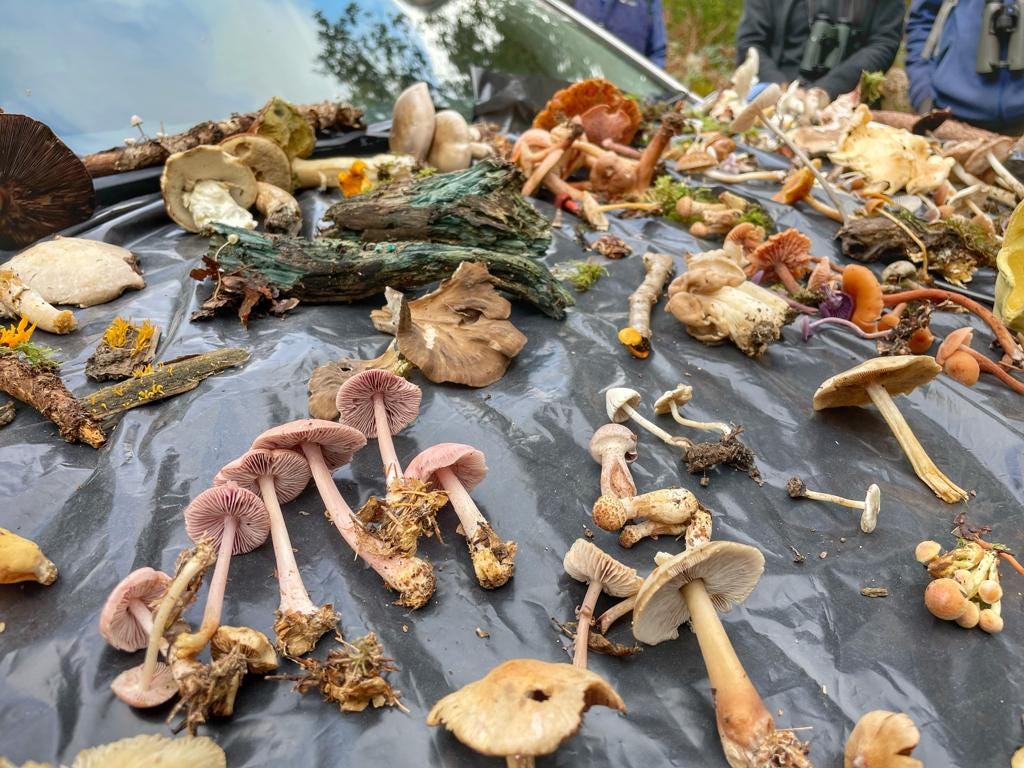Over 50 Species of Fungi recorded in Bentley Wood
Over 50 different species were identified over a single day in October, writes Ailsa McKee
On the Bentley Wood fungus recording day 24 October 2021 some 30 participants split into two groups, one led by James Macpherson and the other by myself, to search for fungi seen in Upper Highwood Copse, a mixed oak woodland to the south west of the wood.
We were fortunate that following a long dry spell in October we had a period of considerable rain prior to this and that seemed to prompt many fungi to fruit. After about two hours all the fungi collected were displayed and some 50 different species identified to the group by James.
In this report I am selecting some of the more distinctive looking fungi found in different areas of Bentley Wood. I am most grateful to M. Sims, C. Marcos and D. Davis who assisted me on many of these forays and on the recording day.
Although the majority of fungi fruit in the autumn, on 11 July I found a young Amanita echinocephala (the Solitaria fungus) with a round white cap covered with triangular white scales, white gills and stout stem with a large scaly sac-like volva at ground level.
The presence of the sac (volva) at the base of the stem often indicates the Genus Amanita and suggests that many could be poisonous. It was growing at the edge of the grassy path while I was recording butterflies in Barnridge. It usually grows on calcareous soil.
Boletus cisalpinus. This distinctive Bolete has a flattened convex brown cap with many cracks on the surface, revealing red flesh beneath. On the cap underside are yellow pores and it has a red stem which turns blue around the foot of the stem if cut or bruised.
Clitocybe odora (Aniseed Funnel). This fungus has convex blue-green cap with whitish gills and pale stem. It has two unusual features; the turquoise colour of the cap and that it smells of aniseed. Usually found on conifer stumps.
Macrotyphula juncea (Slender Pipe). Unlike the above fungi, Slender Pipe has no gills or tubes. It looks like an erect unbranched ochre grass stem with dimensions 0.5-1.0 mm across by 8-15 cm tall. As it grows the leading section develops into a fertile area from which spores are dispersed by wind or rain. It is found among the leaf litter in several areas in Bentley Wood, but this year it was seen in Frenchmoor Copse for the first time.
Helvella lacunosa, ( Elfin Saddle). Another unusual looking fungus similar to the white Helvella crispa which has a cap comprising 2 or 3 distorted whitish/ochre lobes forming the saddle which is free from the longitudinal ridges of the stem.
However H. lacunosa has an equally distorted but black saddle which is attached to the longitudinal ridged stem and can be light or grey. The spores are dispersed from the surface of the saddle by wind etc. Several were found in Pheru Copse.
Tricholomopsis rutilans (Plums & Custard). This fungus has a flattened conical shaped yellow cap but, as it is covered with reddish purple scales, it looks plum coloured – deep colour at the centre and fading towards the inrolled edge of the cap. The gills are a rich yellow, hence the common name. It is often found on pine stumps.
Most of us are aware that fungi reproduce by sending spores into the atmosphere to land on a suitable substrate on which to grow. However the life of fungi and the associations that their hyphae have underground with tree roots is very complicated. It can be beneficial, harmful or mutually beneficial to the host (tree root), and the fungus, as David Attenborough demonstrated in his TV programme The Green Planet.
I wish to thank the Bentley Wood Trustees and David Lambert the manager for granting us access to the Wood and Graham Bennett, Chair of the Friends, for inviting me to organise the recording day. I am also grateful to all the Friends of Bentley Wood who attended especially Tony Goddard and Sue Walker, Graham and Myra Bennett, and Pat Woodruffe for their support on the day. Also many thanks to James Macpherson, who identified the fungi on display to the participants on recording day.
The total number of fungi identified during 2021 that are recorded in Living Record is 218, of which 72 were different species. However without Pat Woodruffe’s persistence and endurance these records would not yet be submitted into Living Record so I am indebted to her.
Watch our video here of James MacPherson identifying fungi recorded in the wood in autumn 2022.






